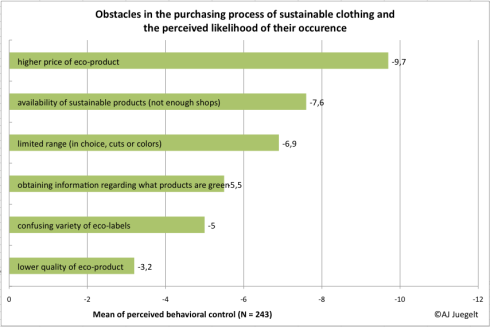You are currently browsing the tag archive for the ‘ability to act’ tag.
SECTION 3 – CONTROL BELIEFS AND THE PERCEIVED LIKELIHOOD OF OCCURRENCE
Perceived behavioral control (PBC) about purchasing eco-friendly clothing stands for the problem of implementation, the missing ability to perform environmentally or socially friendly acts. The level of PBC depends on the positive perception of facilitating factors or the negative perception of obstacles and their likelihood of occurrence, no matter if the control beliefs are rational/true or not (Ajzen 1988)[1]. Perceived control over the behavior accounts for behavioral decisions that are not under complete volitional control. This means that in the context of sustainable, functional outerwear or any other type of consumer behavior regarding eco-friendly products there are several external factors, which prohibit green consumer behavior. Six key factors were used in my paper to account for the obstacles in this context. The set of questions covers some, not all, of the key marketing issues in the areas of product development, pricing, distribution and communication. They contribute to the intention-behavior gap. This gap exists because consumers with very pronounced environmental attitudes might display a strong intention to purchase eco-friendly products (see Section 1), but get obstructed by several obstacles when trying to put their intention into action.
Therefore, the following two sets of questions were asked (as in the previous blog about the effects of social influences on the development of positive or negative purchasing intentions, the results were multiplied):
Which of the following problems affect the amount of environmentally friendly outerwear that you purchase?
- higher price of eco-products
- availability (not enough shops)
- limited range (choice, cuts or colors)
- lower quality of eco-product
- confusing variety of eco-labels
- obtaining information regarding what products are environmentally friendly
‘always a problem’ (-3) to ‘never a problem’ (+3) // note: items are reverse coded
The second step was the consumer’s perceived control or ability to act:
Please indicate below whether or not you believe that these problems are likely to occur when shopping for environmentally friendly outerwear…
Very unlikely (+1) to very likely (+7)

Obstacles in the purchasing process of sustainable clothing and the perceived likelihood of their occurrence (average per item across the entire sample)

